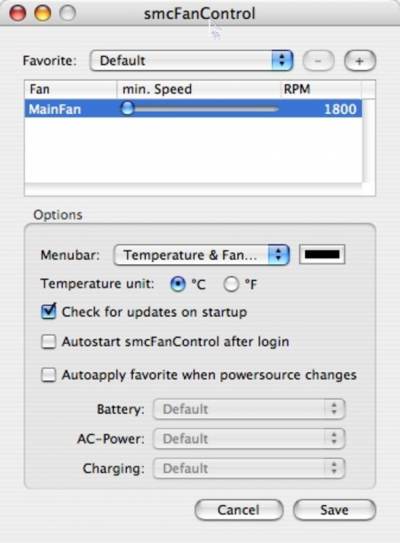
SNET SMCFANCONTROL MAC
Your Mac may also suffer from overheating when running heavy apps and GPU-intensive games, or due to background processes such as Spotlight and Photos indexing. macOS will also lower the clock frequency to give the processor a chance to run slower and cool off. In order to protect the internal components, the built-in fans kick into overdrive to bring the overall temperature of the CPU/GPU/HDD down. I blog from the beaches during the summer so my notebook quickly becomes unbearably hot due to the heat from direct sunlight.
SNET SMCFANCONTROL FREE
The rest of the case top is barely warm.A free macOS app called smcFanControl lets you individually control the fans built into every Mac desktop or notebook in order to make your computer run cooler. As a for instance, running Aperture: most of the heat I notice comes from the harddrive area (left palm). The vast majority of the time, I never notice any fan noise or uncomfortable heat. They will go higher when I'm stressing the 9600 and CPU (X-Plane, for instance). I didn't run it until the fan speeds stabilized, but in a past test they did at about 4400 RPM.

The fans both started ramping up once the case bottomside sensor 4 hit 95F, with CPU diode at 176F.

Just for fun, I ran iTunes Visualizer "G-Force", which is CPU intensive, first with the 9400, then 9600. I take it you're saying the case doesn't feel all that different from when you were running SmcFanControl at >5000 RPM? If so, I guess it's a question of whether that difference balances with a bit more noise. It's interesting the fan does indeed idle at 2000 RPM. Looks like your temps are similar to mine and the case feels about the same, too. Most of the heat I notice is over the top of the hard drive and I don't think the fans have much effect in that area. As cool as this usually runs, I don't expect I'd see much difference. I suggest giving the UB a chance on it's own and see what you think. When the temperature starts to drop, the fans will wait a bit before slowing (probably to prevent "cycling" - again, noise control). Once the temperature rise is arrested, it will slow the fans down to some stable speed (you'll see an overshoot in a graph of fan speed, followed by it leveling out). It doesn't unnecessarily run them (keeping noise down), but slowly ramps up/down as needed. Probably a combination of more sensors, better heat control with both fans and case design, and more refinements in the control algorithm. The fan control tracks temperature very well (even compared with my previous MBP). I don't think there's any warranty problem running it, but I also don't see any reason for using it. Obviously, it doesn't hurt to have them running higher, except perhaps more wear & tear and increased noise (though, I believe the UB's use mag bearings). Anything flat that doesn't block the rear of the machine should be sufficient, though.Īs quiet as the UB fans are, I'd much prefer them below 3000 RPM (they're silent below about that speed). I make sure to always use it on a flat surface or a CoolPad (it only has rubber bumpers - no fans). Easily the coolest running PB/MBP I've owned. Overall, with similar usage, this is noticeable cooler than my 2.33GHz MBP. The bottom is warm to the touch (bottomside case temp reported between about 80F and 90F, depending on sensor). Most of the top case is cool, except over the hard-drive - which is slightly warm at times. Right now, using Safari, Mail and iTunes, with the 9600GPU, I'm seeing ~140F on CPU-A temp diode. Have you tried using the unibody without SmcFanControl? I have an early 2009 17" 2.66GHz and it rarely even gets warm to the touch - even when doing intensive work (CPU and/or GPU).

The device heats up as soon as power is applied, so there's a minimum temp you'll see reported (I use Hardware Monitor).


 0 kommentar(er)
0 kommentar(er)
